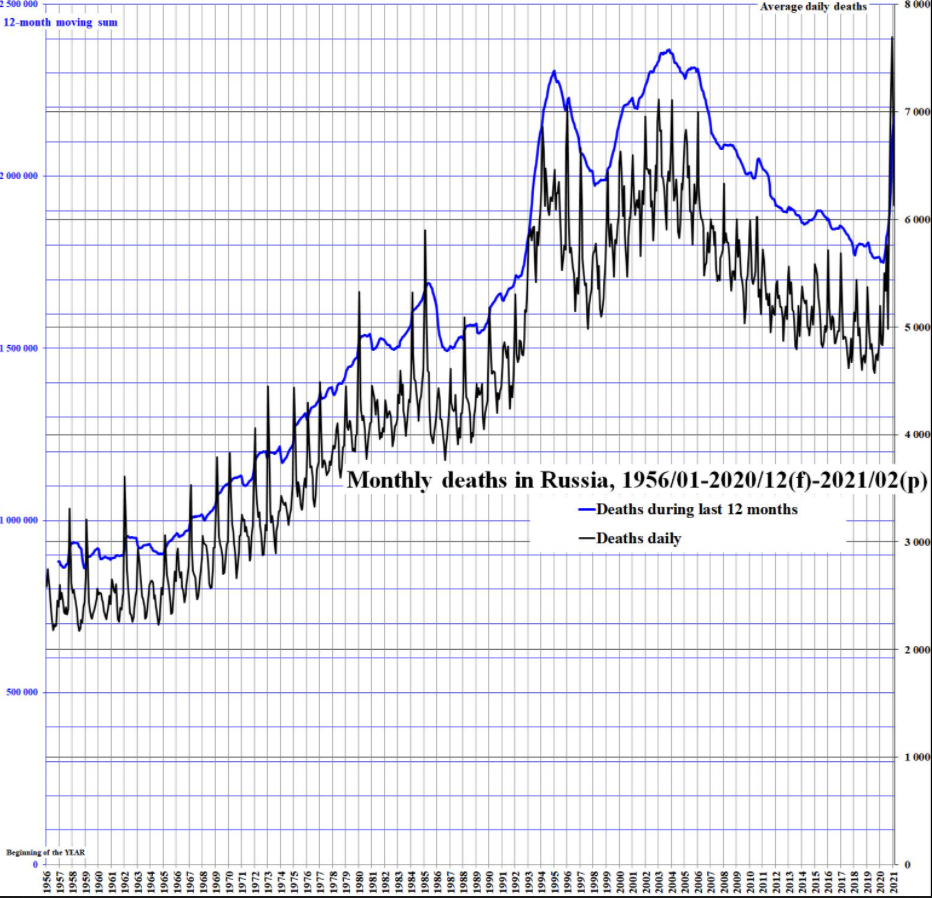The demographic figures for January 2021 are available.
Birth rate
January 2021 saw 106,603 births against 118,820 in January 2020, i.e. 12,217 fewer births and a decrease of 10.3%.
– In central Russia, the birth rate is –5,8%.
The most affected subjects are Kostroma (-26%), Voronezh (-24%), Smolensk (-19.5%) and Yaroslav (-13.7%).
Note that Moscow sees a rise in the birth rate of 14.5%.
– In the Northwestern Federal District, the birth rate is –16,5%.
The most affected subjects are Novgorod (-24.35), Kaliningrad (-22.3%), Voronezh (-24%), and Saint Petersburg (-20.8%).
Only Pskov Oblast sees a birth rate increase of 0.2%.
– In the Southern Federal District, the fall in the birth rate is –10%.
The most affected subjects are Adygea (-22.9%), Sébastopol (-24.6%) and Kalmykia-22.4%).
No subject sees a rise in the birth rate, the Krasnodar Krai is doing the best with a drop in the birth rate of -4.6%.
– In the North Caucasus Federal District, the birth rate is –4,2%.
The most affected subjects are Ingushetia (-21.4%) and Stavropol Krai (-16.6%).
Only Dagestan sees a birth rate increase of 19.5%.
Note that Chechnya sees a drop in the number of births of 13.2%.
– In the Volga Federal District, the birth rate is –14,3%.
The subjects most affected are Penza (-20.6%), Samara (-17.2%) and Mar El (-16.9%).
No subject sees a rise in the birth rate, Chuvashia is doing the best with a drop in the birth rate of -5.3%.
– In the Urals Federal District, the birth rate is –10,6%.
The subjects most affected are Nenetsia (-14.1%), Sverdlovsk (-12.3%) and Kourgan (-12.1%). No subject sees an increase in the birth rate, Tyoumen is doing the best. with a drop in the birth rate of -6.3%.
-In the Federal District of Siberia, the fall in the birth rate is –11,3%.
The most affected subjects are Altai (-16.6%), Tomsk (-16%) and Kemerovo (-14.5%).
Only Tiva sees a birth rate increase of 17.9%.
– In the Far Eastern Federal District, the birth rate is –13,6%.
The subjects most affected are Buryatia (-19.8%), Krai of Zabaïkalskij (-18.5%), Primorié (+ 17%) and Magadan (-14%).
Only Chukotka sees a 20% rise in the birth rate.
Mortality
January 2021 sees 219,769 deaths against 164,075 deaths in January 2020, i.e. 55,694 more deaths and an increase of 33.9%, a situation similar to that of October 2020.
– In central Russia, the increase in mortality is +40%.
The most affected subjects are Moscow (+ 49.8%), Ryazan (+ 46.4%), Orel (+ 46.2%) and Yaroslav (+ 44.7%).
Note that Moscow sees a rise in the birth rate of 14.5%.
– In the Northwestern Federal District, the increase in mortality is +45,7%.
The most affected subjects are Saint Petersburg (+ 55.1%), Kaliningrad (+ 53.4%), Arkhangelsk (+ 50.8%), Karelia (+ 46%).
– In the Southern Federal District, the increase in mortality is +36,1%.
The most affected subjects are Sebastopol (+ 49.6%), Krasnodar Krai (+ 46.3%) and Adygea (+ 35.8%).
– In the North Caucasus Federal District, the increase in mortality is +45,9%.
The most affected subjects are Ingushetia (+ 83.7%), Karachayevo-Cherkessia (+ 52.2%), Chechnya (+ 49.6%) and Dagestan (+ 48.1%).
– In the Volga Federal District, the increase in mortality is + 27,4%.
The most affected subjects are Mordovia (+ 53.7%), Kirov (+ 47.5%), Chuvashia (+ 46%) and Nijni-Novgorod (+ 39.4%).
– In the Urals Federal District, the increase in mortality is +26,6%.
The most affected subjects are Kourgan (+ 33.5%), Sverdlovsk (+ 27.7%) and Khanty-Mansiysk (+ 25.9%).
-In the Federal District of Siberia, the increase in mortality is +23,9%.
The most affected subjects are Altai (+ 35.3%), Tomsk (+ 33.6%) and Tiva (+ 29.2%).
– In the Far Eastern Federal District, the increase in mortality is +28,3%.
The most affected subjects are Kamtchatka (+ 50.3%), Khabarovsk (+ 42.2%) and Sakhalin (+ 32.6%).
*
The excess mortality over the period from April 2020 to January 2021 is 392,362 deaths, so on April 2020 / April 2021 we should have an excess mortality of around 450,000 people.
On the graph below we can look at the mortality curve and see to what extent what happened in 2020 and continues on the beginning of 2021 is not normal in the national demographic dynamics.
Within these 392,362 deaths, according to Rosstat 200,342 would be deaths from the Coronavirus, including 131,118 with the Covid as the sole and main cause of death.
The increase in Covid deaths in the share of excess mortality has been steadily increasing since this fall, plausibly due to statistical catch-ups in the regions, while in Moscow the Coronavirus is responsible for 100% of excess mortality.
According to Rosstat, life expectancy is 71.4 years in 2020 against 73.34 years in 2019, undoubtedly over the period April 2020 / April 2021 this will unfortunately decrease further, reaching 71 years, i.e. a return to the level of 2012 / 2013.

–


